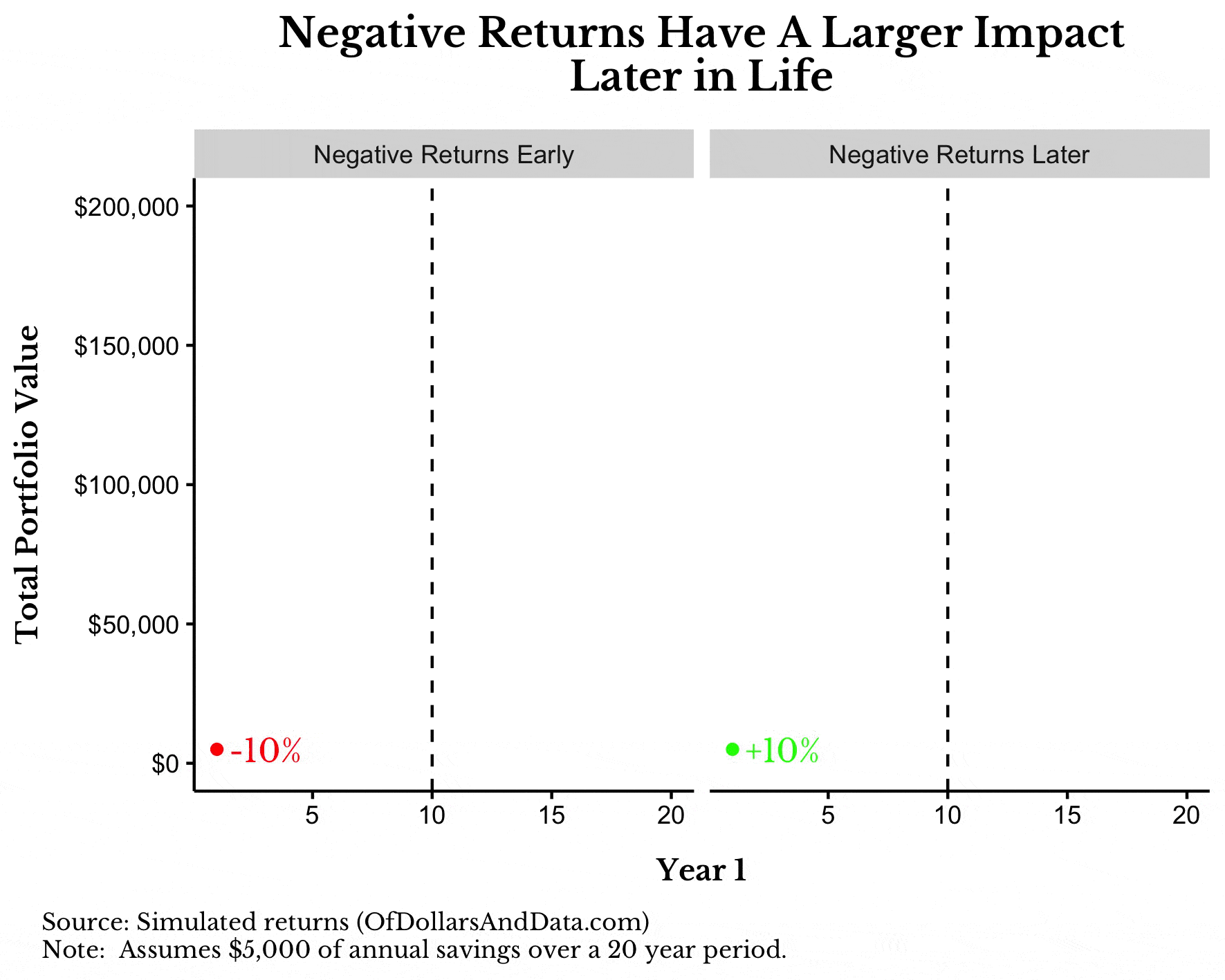I have previously written about how luck can influence your investment results, and this post will continue that discussion, but with some additional complexity. Not only does luck matter, but, in particular, your returns right before and in the first years of your retirement will have a disproportionate impact on your investment success. In other words:
The end is everything.
Before I discuss what you can do to mitigate this risk, let’s start with a thought experiment to explain this concept.
Suppose you put $10,000 into an investment account and then you experienced the following returns over the next 4 years: +25% in year 1, +10% in year 2, -10% in year 3, and -25% in year 4.
Would you have been better off if you had gotten the returns in a different order? For example, does -25% in year 1, -10% in year 2, +10% in year 3, +25% in year 4 change your final investment value?
The answer is no.
When using a lump sum (i.e. investing money without adding or subtracting additional funds), the order of your returns do not matter. If you don’t believe me, spend a minute trying to prove how 3 * 2 * 1 is not equal to 1 * 2 * 3.
Now, what happens if you add money to your invested funds over time? Is there a difference between +10%, +25%, -10%, -25% and -25%, -10%, +10%, +25%?
Yes.
When you are adding money over time it is best to have the higher returns at the end, not the beginning, of your investment life.
Why?
You want the highest returns when you have the most money in play. As you add money to your invested funds over time, your risk gets amplified such that a negative return in later years will cost you more in absolute dollar terms than in earlier years. Therefore, downturns early in your investing life can be ideal, as their impact on your final portfolio value are small compared to downturns later in your investment life.
Given you will be acquiring more assets over time, like the vast majority of investors, the timing of your returns matters more than almost any other financial risk you will face. The investment risk I am describing is formally known as sequence of return risk, and is summarized quite well by Michael Kitces in this post.
To visualize sequence of return risk, imagine saving $5,000 a year for 20 years under 2 different scenarios:
- You receive 10 years of -10% returns, then 10 years of +10% returns. We will call this scenario (“Negative Returns Early”).
- You receive 10 years of +10% returns, then 10 years of -10% returns. We will call this scenario (“Negative Returns Later”).
Both scenarios have the same geometric and arithmetic average return over the 20 year period, the only difference is the timing of the returns relative to your invested funds. Let’s see how you would end up by looking at the total value of your portfolio under each scenario over time:
As you can see, getting the negative returns later in life, when you have the most money in play, leaves you far worse off than if you experienced those negative returns when you first started investing. If you experience larger negative returns as you approach/enter retirement, your nest egg could be reduced significantly and you might not live long enough to see it bounce back. What makes this scenario worse is that, in retirement, you will be subtracting money from your invested funds. This will deplete your nest egg even faster in the midst of a downturn. However, there are ways to mitigate this risk that I will highlight shortly.
The one positive takeaway from the above plot is that younger investors should not worry about their returns…yet. As I have mentioned previously, younger/poorer investors should focus on their savings and building their skills. This will have a far larger absolute dollar payoff than worrying about your investment returns on smaller sums of money.
How to Prepare for the End Game
When it comes to retirement planning and preparing for the end game, the strategies are complex and highly based on individual preferences and needs. This post would be far too lengthy to cover them all. However, there are a few ways to counteract the effects of a downturn in retirement:
- Adequately diversify with enough low risk assets (i.e. bonds). Having a large bond portion (≥50%) as you enter retirement may be able to provide enough income to prevent you from selling equities at depressed prices. In the normal course of rebalancing, you may be able to sell some of your bonds such that you would not need to worry about what happened in the stock market.
- Consider withdrawing less money during market downturns. If you had originally planned withdrawing 4% a year, temporarily lowering this to a smaller withdrawal rate would help mitigate the damage done by a market crash (assuming you have to sell assets at depressed prices).
- Consider working part time to supplement your income. In the book How To Retire Happy, Wild, and Free, Ernie Zelinski discusses many of the non-financial aspects of retirement including working on something new that could also produce income. I highly recommend the book and believe that work and accomplishment are important for everyone, including retirees.
Thank you for reading!
If you liked this post, consider signing up for my newsletter.
This is post 24. Any code I have related to this post can be found here with the same numbering: https://github.com/nmaggiulli/of-dollars-and-data


